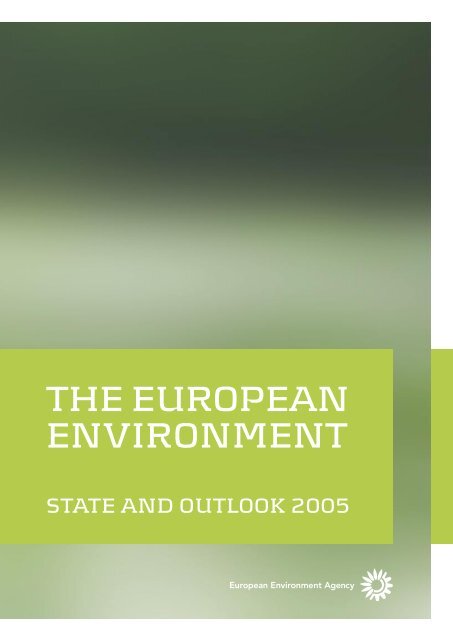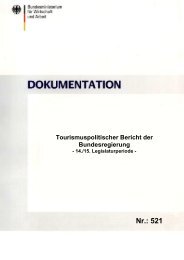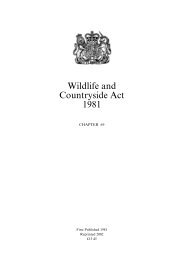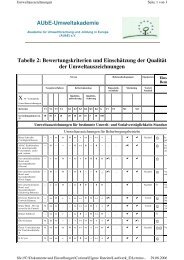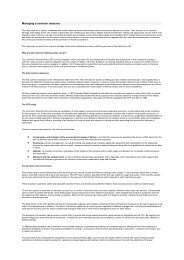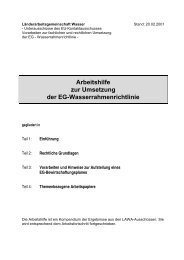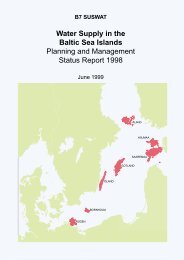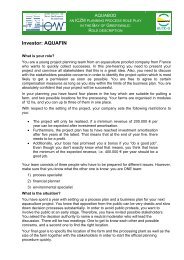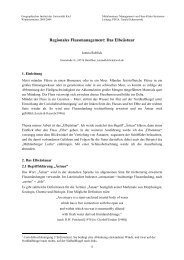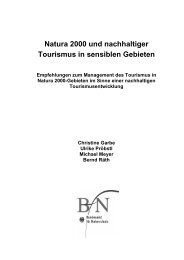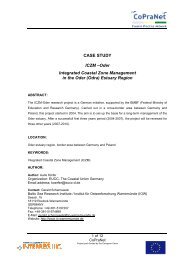The European environment - State and outlook ... - IKZM-D Lernen
The European environment - State and outlook ... - IKZM-D Lernen
The European environment - State and outlook ... - IKZM-D Lernen
You also want an ePaper? Increase the reach of your titles
YUMPU automatically turns print PDFs into web optimized ePapers that Google loves.
THE EUROPEAN<br />
ENVIRONMENT<br />
STATE AND OUTLOOK 2005
THE EUROPEAN<br />
ENVIRONMENT<br />
STATE AND OUTLOOK 2005
Cover design: EEA<br />
Layout: EEA<br />
Photos © Monica Rzeszot, 2005<br />
Pages 15, 19, 21, 23, 24, 35, 91, 111, 181,<br />
250, 254, 267, 283, 307, 319, 411, 524, 528.<br />
Legal notice<br />
<strong>The</strong> contents of this publication do not necessarily reflect the official opinions of the <strong>European</strong><br />
Commission or other institutions of the <strong>European</strong> Communities. Neither the <strong>European</strong> Environment<br />
Agency nor any person or company acting on behalf of the Agency is responsible for the use that may<br />
be made of the information contained in this report.<br />
All rights reserved<br />
No part of this publication may be reproduced in any form or by any means electronic or mechanical,<br />
including photocopying, recording or by any information storage retrieval system, without the<br />
permission in writing from the copyright holder. For translation or reproduction rights please contact<br />
EEA (address information below).<br />
Citation<br />
<strong>European</strong> Environment Agency, 2005. <strong>The</strong> <strong>European</strong> <strong>environment</strong> — <strong>State</strong> <strong>and</strong> <strong>outlook</strong> 2005.<br />
Copenhagen<br />
Information about the <strong>European</strong> Union is available on the Internet. It can be accessed through the<br />
Europa server (http://europa.eu.int).<br />
Luxembourg: Office for Official Publications of the <strong>European</strong> Communities, 2005<br />
ISBN 92-9167-776-0<br />
© EEA, Copenhagen 2005<br />
Environmental production<br />
This publication is printed according to high <strong>environment</strong>al st<strong>and</strong>ards.<br />
Printed by Scanprint a/s<br />
— Environment Certificate: ISO 14001<br />
— Quality Certificate: ISO 9001: 2000<br />
— EMAS registered — licence no. DK- S-000015<br />
— Approved for printing with the Nordic Swan <strong>environment</strong>al label, licence no. 541 055<br />
Paper<br />
— Multicopy original — woodfree mat fine paper, TCF, ISO 9706<br />
— <strong>The</strong> Nordic Swan label<br />
Printed in Denmark<br />
<strong>European</strong> Environment Agency<br />
Kongens Nytorv 6<br />
1050 Copenhagen K<br />
Denmark<br />
Tel.: +45 33 36 71 00<br />
Fax: +45 33 36 71 99<br />
Web: www.eea.eu.int<br />
Enquiries: www.eea.eu.int/enquiries
THE EUROPEAN<br />
ENVIRONMENT<br />
STATE AND OUTLOOK 2005
List of contents<br />
Integrated assessment<br />
Foreword 8<br />
Introduction 10<br />
Executive summary 16<br />
PART A | Integrated assessment<br />
Integrated assessment<br />
Setting the scene<br />
1 Environment <strong>and</strong> quality of life 28<br />
2 <strong>The</strong> changing face of Europe 36<br />
Atmospheric <strong>environment</strong><br />
3 Climate change 62<br />
4 Air pollution <strong>and</strong> health 92<br />
Aquatic <strong>environment</strong><br />
5 Freshwaters 112<br />
6 Marine <strong>and</strong> coastal <strong>environment</strong> 132<br />
Terrestrial <strong>environment</strong><br />
7 Soil 168<br />
8 Biodiversity 182<br />
Integration<br />
9 Environment <strong>and</strong> economic sectors 216<br />
10 Looking ahead 232<br />
PART B | Core set of indicators<br />
Setting the scene 255<br />
Air pollution <strong>and</strong> ozone depletion<br />
01 Emissions of acidifying substances 256<br />
02 Emissions of ozone precursors 260<br />
03 Emissions of primary particles <strong>and</strong> secondary particulate precursors 264<br />
04 Exceedance of air quality limit values in urban areas 268<br />
05 Exposure of ecosystems to acidification, eutrophication <strong>and</strong> ozone 272<br />
06 Production <strong>and</strong> consumption of ozone depleting substances 276<br />
Biodiversity<br />
07 Threatened <strong>and</strong> protected species 280<br />
08 Designated areas 284<br />
09 Species diversity 288<br />
Climate change<br />
10 Greenhouse gas emissions <strong>and</strong> removals 292<br />
11 Projections of greenhouse gas emissions <strong>and</strong> removals 296<br />
12 Global <strong>and</strong> <strong>European</strong> temperature 300<br />
13 Atmospheric greenhouse gas concentrations 304
Terrestrial<br />
14 L<strong>and</strong> take 308<br />
15 Progress in management of contaminated sites 312<br />
Waste<br />
16 Municipal waste generation 316<br />
17 Generation <strong>and</strong> recycling of packaging waste 320<br />
Water<br />
18 Use of freshwater resources 324<br />
19 Oxygen consuming substances in rivers 328<br />
20 Nutrients in freshwater 332<br />
21 Nutrients in transitional, coastal <strong>and</strong> marine waters 336<br />
22 Bathing water quality 340<br />
23 Chlorophyll in transitional, coastal <strong>and</strong> marine waters 344<br />
24 Urban wastewater treatment 348<br />
Agriculture<br />
25 Gross nutrient balance 352<br />
26 Area under organic farming 356<br />
Energy<br />
27 Final energy consumption by sector 360<br />
28 Total energy intensity 364<br />
29 Total energy consumption by fuel 368<br />
30 Renewable energy consumption 372<br />
31 Renewable electricity 376<br />
Fisheries<br />
32 Status of marine fish stocks 380<br />
33 Aquaculture production 384<br />
34 Fishing fleet capacity 388<br />
Transport<br />
35 Passenger transport dem<strong>and</strong> 392<br />
36 Freight transport dem<strong>and</strong> 396<br />
37 Use of cleaner <strong>and</strong> alternative fuels 400<br />
PART C | Country analysis<br />
Setting the scene — main results 408<br />
EEA scorecard 412<br />
<strong>The</strong>matic assessment<br />
Greenhouse gas emissions 414<br />
Total energy consumption 416<br />
Renewable electricity 418<br />
Emissions of acidifying substances 420<br />
Emissions of ozone precursors 422<br />
Freight transport dem<strong>and</strong> 424
PART C | Country analysis<br />
Area under organic farming 426<br />
Municipal waste generation 428<br />
Use of freshwater resources 430<br />
Country perspectives 432<br />
Austria 434<br />
Belgium 436<br />
Bulgaria 438<br />
Cyprus 440<br />
Czech Republic 442<br />
Denmark 444<br />
Estonia 446<br />
Finl<strong>and</strong> 448<br />
France 450<br />
Germany 452<br />
Greece 454<br />
Hungary 456<br />
Icel<strong>and</strong> 458<br />
Irel<strong>and</strong> 460<br />
Italy 462<br />
Latvia 464<br />
Liechtenstein 466<br />
Lithuania 468<br />
Luxembourg 470<br />
Malta 472<br />
<strong>The</strong> Netherl<strong>and</strong>s 474<br />
Norway 476<br />
Pol<strong>and</strong> 478<br />
Portugal 480<br />
Romania 482<br />
Slovak Republic 484<br />
Slovenia 486<br />
Spain 488<br />
Sweden 490<br />
Switzerl<strong>and</strong> 492<br />
Turkey 494<br />
United Kingdom 496<br />
Methodology <strong>and</strong> main decision points 498<br />
Ranking graphs 508
PART D | Bibliography<br />
Introduction 529<br />
Previous state-of-the-<strong>environment</strong> reports 530<br />
Signals reports 531<br />
Reports 2000–2005, by theme:<br />
Air pollution 532<br />
Climate change 534<br />
Terrestrial <strong>environment</strong> <strong>and</strong> biodiversity 536<br />
Waste <strong>and</strong> material flows 537<br />
Water 539<br />
Agriculture 542<br />
Energy 543<br />
Transport 544<br />
Other issues 546<br />
Policy measures <strong>and</strong> instruments 549<br />
Eionet development <strong>and</strong> information systems, by theme 552<br />
Condensed list of reports 2000–2005, by series:<br />
Environmental assessment reports (2000–2003) 566<br />
Environmental issue reports (2000–2004) 566<br />
EEA reports (2004–2005) 567<br />
EEA briefings (2003–2005) 567<br />
Topic reports (2000–2003) 567<br />
Technical reports (2000–2003) 568<br />
EEA technical reports (2004–2005) 570
Foreword<br />
This is the third state <strong>and</strong> <strong>outlook</strong> report on the<br />
<strong>European</strong> <strong>environment</strong> produced by the <strong>European</strong><br />
Environment Agency (EEA) since 1994. Looking back,<br />
the last report, published in 1999 concluded that,<br />
despite 25 years of Community <strong>environment</strong>al policy,<br />
<strong>environment</strong>al quality in the <strong>European</strong> Union (EU)<br />
was mixed <strong>and</strong> that the unsustainable development<br />
of some key economic sectors was the major barrier<br />
to further improvements. That remains the EEA's<br />
key conclusion, despite significant progress on some<br />
issues demonstrating that <strong>environment</strong>al policy works.<br />
Were we to fast-forward to the year 2010, it would<br />
be my strong hope that in its next state <strong>and</strong> <strong>outlook</strong><br />
report, the EEA would be able to report significant<br />
<strong>environment</strong>al improvements, not least as a result<br />
of reversing unsustainable trends in sectors such as<br />
energy, agriculture <strong>and</strong> transport.<br />
Much has of course changed in Europe since 1999, most<br />
notably through the biggest ever enlargement of the<br />
EU. Despite this <strong>and</strong> other considerable successes, the<br />
EU now recognises that it has to do more to convey<br />
to <strong>European</strong>s that it underst<strong>and</strong>s their concerns <strong>and</strong><br />
that it has credible strategies in place to address them.<br />
One response has been to reinvigorate the Lisbon<br />
agenda initially launched in 2000 with the target of<br />
creating new <strong>and</strong> better jobs through higher economic<br />
growth. <strong>The</strong> EU has set itself the deadline of 2010 for<br />
delivering on this agenda <strong>and</strong> against this backdrop<br />
<strong>environment</strong>al initiatives are being rigorously<br />
scrutinised. At the same time, opinion polls show<br />
that the <strong>European</strong> public believes that <strong>environment</strong><br />
protection policies are an incentive for innovation <strong>and</strong><br />
not an obstacle to economic performance. <strong>The</strong> evidence<br />
in this report shows that they are right.<br />
<strong>The</strong> years since 1999 have also witnessed the adoption<br />
of the EU's sustainable development strategy. At the<br />
UN World Summit on Sustainable Development in the<br />
summer of 2002, the EU showed global leadership by<br />
setting out its broad, long-term vision for the future.<br />
But long-term objectives must not mean postponing<br />
action now. In formulating policy today, Europe has<br />
an obligation to look beyond 2010 <strong>and</strong> beyond its<br />
own borders. As this report shows, the international<br />
stakes are high. Europe cannot continue down<br />
the path of achieving its short-term objectives by<br />
impacting disproportionately on the rest of the world's<br />
<strong>environment</strong> through its ecological footprint.<br />
Tackling clearly unsustainable trends in Europe will<br />
require real integration of <strong>environment</strong>al objectives<br />
across policy areas such as energy, transport,<br />
agriculture, industry <strong>and</strong> spatial planning. Consumers<br />
must also be given the information <strong>and</strong> incentives to<br />
change the way in which their households <strong>and</strong> lifestyles<br />
impact upon their local — <strong>and</strong> global — <strong>environment</strong>s.<br />
It is not easy to bring about such shifts in behaviour but<br />
many of the <strong>environment</strong>al improvements that we need<br />
in the coming years can only be brought about through<br />
such changes. At the same time, the EU must remain<br />
vigilant to ensure that the policy measures already in<br />
place are fully implemented <strong>and</strong> properly enforced.<br />
<strong>The</strong> <strong>European</strong> public's intuitive underst<strong>and</strong>ing that<br />
<strong>environment</strong>al protection <strong>and</strong> economic growth can<br />
go h<strong>and</strong> in h<strong>and</strong> is confirmed by this report. <strong>The</strong> same<br />
applies to the widely held view that prevention works<br />
better than cure. Many <strong>environment</strong>al problems stem<br />
from incorrect pricing of what we consume at the time<br />
we consume it. <strong>The</strong> challenge for <strong>European</strong> policymakers<br />
is to ensure that the real costs of pollution <strong>and</strong><br />
resource inefficiency are internalised into the prices<br />
of products <strong>and</strong> services, as opposed to later on at the<br />
end of the chain in the form of a pollution clean-up bill,<br />
damaged health or diminished ecosystems. <strong>The</strong> tools<br />
of the market can provide incentives to bring about<br />
some of the very necessary behavioural changes. And<br />
as the EEA has shown in some of its earlier reports, the<br />
cost of inaction can be many times the cost of sensible<br />
preventive measures.<br />
Some phenomena are more difficult to cost in<br />
conventional market terms. As societies we have come<br />
to rely on a range of ecosystem services upon which<br />
we have not traditionally placed monetary values.<br />
Healthy ecosystems deliver an abundance of free <strong>and</strong><br />
life-sustaining services such as productive l<strong>and</strong> <strong>and</strong><br />
soil, forest products, or other, sometimes less well<br />
recognised services, such as watershed protection<br />
<strong>and</strong> water filtration, flood protection or carbon<br />
storage. Our economies — like our societies — are<br />
8 <strong>The</strong> <strong>European</strong> <strong>environment</strong> | <strong>State</strong> <strong>and</strong> <strong>outlook</strong> 2005
Foreword<br />
dependent upon these often hidden services. <strong>The</strong> seas<br />
<strong>and</strong> coasts around Europe provide one example of a<br />
vital resource upon which many millions of people<br />
depend, both economically <strong>and</strong> culturally. And yet,<br />
the current deterioration of our marine ecosystems, as<br />
seen through the depletion of fish stocks, puts at risk<br />
the services they provide. Similarly, climate change<br />
is already altering ecosystems in such a way that we<br />
must ask ourselves about their capacity to adapt. While<br />
ecosystems are extremely resilient <strong>and</strong> typically only<br />
change rather slowly, there are growing signs from<br />
across the world that they can reach a critical point<br />
where they undergo 'greenlash' — or a sudden flip into<br />
a new structure.<br />
We need to keep a strong time perspective uppermost<br />
in our minds when assessing Europe's changing<br />
<strong>environment</strong>. Changes can often be subtle <strong>and</strong> long-term<br />
<strong>and</strong> as such they may require sustained policy responses<br />
over a long period. At the same time, by taking the<br />
longer view, we may see that slow changes can be<br />
dramatic <strong>and</strong> that there is cause to sound the alarm now.<br />
For example, the Millennium Ecosystem Assessment has<br />
recently shown that humans have changed ecosystems<br />
more rapidly <strong>and</strong> extensively in the last 50 years than in<br />
any other period of human history.<br />
For its part, the EEA is responding to the need for longterm,<br />
integrated analyses of <strong>environment</strong>al issues that<br />
take account of the global context. We are working with<br />
others on <strong>environment</strong>al accounting methods that link<br />
<strong>environment</strong>al pressures to economic sector activities<br />
in ways that are consistent with national economic<br />
accounts. In 2006 we will start to review with our<br />
partners, how we produce <strong>environment</strong>al <strong>outlook</strong>s with<br />
a view to making future modelling work more policy<br />
relevant. <strong>The</strong> EEA will also extend its work on scenarios<br />
development to provide decision-makers with new<br />
tools <strong>and</strong> insights into possible <strong>environment</strong>al futures<br />
<strong>and</strong> their associated socio-economic developments.<br />
<strong>The</strong>se could provide a more robust basis for longerterm<br />
policy considerations.<br />
By the time of the fourth state <strong>and</strong> <strong>outlook</strong> report on the<br />
<strong>European</strong> <strong>environment</strong> in 2010, the EEA intends to have<br />
played its part in helping to reverse the unsustainable<br />
trends that have been consistently identified in our<br />
work since 1994. We hope that the present report can<br />
help show governments <strong>and</strong> the public what is at stake<br />
in needing to move towards the more eco-efficient <strong>and</strong><br />
equitable economic activities upon which Europe's<br />
future growth depends.<br />
In conclusion, I would like to take this opportunity<br />
to thank Agency staff, members of the <strong>European</strong><br />
<strong>environment</strong> information <strong>and</strong> observation network<br />
(Eionet), other EEA stakeholders, <strong>and</strong> external<br />
consultants who contributed to the drafting, editing,<br />
review <strong>and</strong> production of the report. In addition, I<br />
would like to thank everyone who provided data<br />
<strong>and</strong> information, especially Eionet, the <strong>European</strong><br />
Commission services, international organisations <strong>and</strong><br />
the secretariats of international conventions.<br />
Professor Jacqueline McGlade<br />
Executive Director<br />
<strong>The</strong> <strong>European</strong> <strong>environment</strong> | <strong>State</strong> <strong>and</strong> <strong>outlook</strong> 2005<br />
9
Foreword<br />
Introduction<br />
1 M<strong>and</strong>ate <strong>and</strong> purpose<br />
<strong>The</strong> <strong>European</strong> Environment Agency (EEA) together<br />
with its <strong>European</strong> Environment Information <strong>and</strong><br />
Observation Network (Eionet) began working in 1994<br />
to provide the EU Member <strong>State</strong>s, other EEA member<br />
countries, <strong>and</strong> the <strong>European</strong> Commission with<br />
objective, reliable <strong>and</strong> comparable information on the<br />
state, pressures <strong>and</strong> sensitivities of the <strong>environment</strong><br />
in the <strong>European</strong> Union (EU) <strong>and</strong> its surroundings.<br />
Specifically, under its founding Regulation<br />
(EEC/1210/90), the EEA is required to 'publish a<br />
report on the state of, trends in <strong>and</strong> prospects for<br />
the <strong>environment</strong> every five years, supplemented by<br />
indicator reports focusing upon specific issues'.<br />
<strong>The</strong> present report <strong>The</strong> <strong>European</strong> <strong>environment</strong> —<br />
<strong>State</strong> <strong>and</strong> <strong>outlook</strong> 2005 is the third such report<br />
produced since the EEA was established. <strong>The</strong> reports<br />
are intended to support strategic <strong>environment</strong>al<br />
programming in the EU <strong>and</strong> beyond. Previous reports<br />
were Environment in the <strong>European</strong> Union 1995: report<br />
for the review of the 5th <strong>environment</strong> action programme,<br />
published in 1995 <strong>and</strong> Environment in the <strong>European</strong><br />
Union at the turn of the century, published in 1999.<br />
<strong>The</strong> latter contributed to the global assessment of<br />
the 5th <strong>environment</strong> action programme, a process<br />
that acted as a prelude to the development of the 6th<br />
<strong>environment</strong> action programme (6th EAP), adopted<br />
in 2002. This 2005 state <strong>and</strong> <strong>outlook</strong> report provides<br />
timely input to strategic policy review processes, the<br />
most important of which is the mid-term review of the<br />
6th EAP scheduled for completion in 2006.<br />
According to its founding regulation, the EEA's five<br />
year reports are intended to describe past, present <strong>and</strong><br />
future perspectives for the <strong>environment</strong>. <strong>The</strong> overall<br />
purpose is to provide an integrated assessment that<br />
forms the basis for underst<strong>and</strong>ing what are the main<br />
challenges facing Europe's <strong>environment</strong> today <strong>and</strong> in<br />
the future, within the context of changing economic<br />
<strong>and</strong> social dynamics both in Europe <strong>and</strong> across the<br />
world.<br />
<strong>The</strong> rapidly changing economic <strong>and</strong> demographic<br />
l<strong>and</strong>scapes of Europe <strong>and</strong> the world, together with<br />
the shift in the source of <strong>environment</strong>al problems in<br />
Europe from production to consumption patterns<br />
in the last decades are two of the main socioeconomic<br />
changes that underpin the <strong>environment</strong>al<br />
assessment presented in this report. In addition, the<br />
increasing relevance of international trade, as well<br />
as the growing competition for resources between<br />
developed economies such as Europe, <strong>and</strong> emerging<br />
economies such as China, India <strong>and</strong> Brazil, are two<br />
key developments that influence both <strong>European</strong><br />
<strong>and</strong> global <strong>environment</strong>s as a result of the external<br />
footprint of Europe's activities.<br />
It is in the context of these main socio-economic<br />
changes that the report addresses the resulting<br />
<strong>environment</strong>al <strong>and</strong> human health impacts from<br />
increasing urbanisation <strong>and</strong> rural l<strong>and</strong> ab<strong>and</strong>onment,<br />
climate change, air pollution <strong>and</strong> other chemical<br />
exposures, depletion of natural resources such as<br />
water, soil <strong>and</strong> biodiversity <strong>and</strong> the disturbance<br />
caused to l<strong>and</strong>-based <strong>and</strong> marine ecosystems.<br />
<strong>The</strong>se past <strong>and</strong> future trends for the <strong>environment</strong><br />
<strong>and</strong> society are considered alongside the wide range<br />
of policy measures adopted at the national, EU <strong>and</strong><br />
global levels. <strong>The</strong> report describes the range <strong>and</strong> role<br />
of policy instruments available <strong>and</strong> shows, in a more<br />
limited way, how effective these policies have been<br />
in meeting their objectives. Regulations <strong>and</strong> market<br />
measures are given particular attention in view of<br />
their roles in reducing <strong>environment</strong>al pressures<br />
through encouraging developments in <strong>environment</strong>al<br />
technologies <strong>and</strong> behavioural change.<br />
<strong>The</strong> EEA uses its driving forces — pressures<br />
— state — impact — responses (DPSIR) assessment<br />
framework to guide its work on integrated<br />
assessment. <strong>The</strong> DPSIR framework provides a basis<br />
for analysing the interrelated factors that impact the<br />
<strong>environment</strong>, including societal driving forces such as<br />
production <strong>and</strong> consumption patterns, their pressures<br />
on the <strong>environment</strong>, the resulting changes in the<br />
state of the <strong>environment</strong>, its impacts on ecosystems<br />
<strong>and</strong> health, <strong>and</strong> the role <strong>and</strong> effectiveness of policy<br />
measures in managing these interlinked dynamics.<br />
10<br />
<strong>The</strong> <strong>European</strong> <strong>environment</strong> | <strong>State</strong> <strong>and</strong> <strong>outlook</strong> 2005
Introduction<br />
Data <strong>and</strong> information used in the report for assessing<br />
past trends have been gathered through Eionet,<br />
a partnership of the EEA <strong>and</strong> its member <strong>and</strong><br />
participating countries. It consists of the EEA itself, five<br />
<strong>European</strong> Topic Centres, <strong>and</strong> a network of around 1 000<br />
experts from 31 member countries <strong>and</strong> 6 collaborating<br />
countries, representing over 300 national <strong>environment</strong><br />
agencies <strong>and</strong> other bodies dealing with <strong>environment</strong>al<br />
information. Other key data sources used in the<br />
report include the <strong>European</strong> Commission services,<br />
especially DG Environment, DG Eurostat <strong>and</strong> DG Joint<br />
Research Centre, <strong>and</strong> the secretariats of international<br />
conventions. <strong>The</strong> EEA has also worked in cooperation<br />
with these <strong>and</strong> other partners to produce information<br />
on <strong>outlook</strong>s for the <strong>environment</strong> using established<br />
modelling <strong>and</strong> scenarios tools to assure consistency<br />
with other processes.<br />
2 Report structure <strong>and</strong> target<br />
audiences<br />
This report is divided into four parts: Part A: an<br />
integrated assessment; Part B: core set of indicators;<br />
Part C: country analysis; <strong>and</strong>, Part D: bibliography of<br />
EEA publications since 2000.<br />
Part A<br />
Part A provides an integrated assessment at the<br />
<strong>European</strong> level across the main <strong>environment</strong>al<br />
challenges that Europe faces <strong>and</strong> how these are<br />
influenced by socio-economic activities at home <strong>and</strong><br />
more widely across the world. It considers both past<br />
trends <strong>and</strong> future prospects. It is structured in five<br />
main sections, each containing two chapters.<br />
<strong>The</strong> first section, called 'setting the scene', has chapters<br />
addressing <strong>environment</strong>'s contribution to our quality of<br />
life <strong>and</strong> how the face of Europe has changed in recent<br />
times through its changing l<strong>and</strong>scape patterns. <strong>The</strong><br />
first chapter looks at how citizens perceive the role of<br />
the <strong>environment</strong> alongside social <strong>and</strong> economic aspects<br />
in improving their overall welfare. <strong>The</strong> chapter on<br />
l<strong>and</strong>scapes combines an assessment of the potential<br />
of Europe's l<strong>and</strong> area to continue providing ecological<br />
goods <strong>and</strong> services in the face of changing pressures,<br />
<strong>and</strong> an explanation of the main policy instruments at<br />
the <strong>European</strong> level that are influencing change.<br />
<strong>The</strong> section on atmospheric <strong>environment</strong> addresses<br />
climate change, the foremost <strong>environment</strong>al challenge<br />
facing Europe <strong>and</strong> the world today, <strong>and</strong> air pollution<br />
<strong>and</strong> its impacts on people's health. In both chapters,<br />
particular attention is given to the challenges posed<br />
by pollution from households, energy supply <strong>and</strong><br />
transport, <strong>and</strong> the sensitivities in dealing with these<br />
through policy responses aimed at behavioural<br />
change. Particular attention is also given to the future<br />
challenges <strong>and</strong> the costs of action/inaction in the face of<br />
uncertainty.<br />
<strong>The</strong> section on aquatic <strong>environment</strong> has chapters<br />
covering freshwater, <strong>and</strong> marine <strong>and</strong> coastal<br />
<strong>environment</strong>s. <strong>The</strong> freshwater chapter focuses on the<br />
main pollution sources <strong>and</strong> trends — with less focus<br />
on ecological <strong>and</strong> ecosystem aspects because of lack<br />
of data — <strong>and</strong> on how managing freshwaters will<br />
continue to be a long-term <strong>and</strong> costly endeavour for<br />
Europe. <strong>The</strong> marine <strong>and</strong> coastal chapter focuses much<br />
more on ecosystem aspects <strong>and</strong> especially on the<br />
important <strong>and</strong> fragile nature of coasts <strong>and</strong> oceans in the<br />
context of climate change.<br />
<strong>The</strong> terrestrial <strong>environment</strong> section includes chapters<br />
on soil <strong>and</strong> biodiversity. <strong>The</strong> soil chapter reflects the<br />
present paucity of data <strong>and</strong> analysis for this area.<br />
Nevertheless, it provides some useful insights as well<br />
as a clear basis for underst<strong>and</strong>ing the challenges ahead<br />
for Europe on soil monitoring <strong>and</strong> modelling. <strong>The</strong><br />
biodiversity chapter provides a comprehensive analysis<br />
of terrestrial ecosystems <strong>and</strong> species <strong>and</strong> of how<br />
Europe influences the use of natural resources globally<br />
as shown by its ecological footprint.<br />
<strong>The</strong> final section of chapters on integration assesses the<br />
<strong>environment</strong>al impacts of main economic sectors —<br />
agriculture, transport, energy <strong>and</strong> households — in the<br />
context of improving eco-efficiency. It concludes with<br />
some reflections on where priorities could lie for future<br />
action through improved policy design <strong>and</strong> coherence,<br />
better governance structures <strong>and</strong> investments in ecoinnovation<br />
that could together deliver cost-effective<br />
<strong>The</strong> <strong>European</strong> <strong>environment</strong> | <strong>State</strong> <strong>and</strong> <strong>outlook</strong> 2005<br />
11
Introduction<br />
improvements to Europe's <strong>environment</strong>, economy<br />
<strong>and</strong> overall quality of life in the face of changing<br />
demographics.<br />
<strong>The</strong> assessment for Part A is written in a more accessible<br />
style <strong>and</strong> as such is targeted to an informed political<br />
<strong>and</strong> public audience working mainly outside the<br />
<strong>environment</strong> sphere but for whom <strong>environment</strong>al<br />
concerns play a role in their day-to-day activities <strong>and</strong><br />
decision-making. Examples include politicians <strong>and</strong><br />
policy-makers working in the economic sectors that<br />
have most influence on the <strong>environment</strong> — agriculture,<br />
transport, industry, tourism <strong>and</strong> trade; the financial<br />
community, where <strong>environment</strong>al issues are of<br />
increasing relevance to decisions around insurance risk<br />
<strong>and</strong> investment choices; the research <strong>and</strong> development<br />
community, which would be the source of many of the<br />
innovations that could contribute to reducing future<br />
<strong>environment</strong>al pressures <strong>and</strong> impacts; <strong>and</strong> the informed<br />
public. All of these groups have an interest in how<br />
Europe's <strong>environment</strong> is developing, from the local<br />
through to the global level, <strong>and</strong> in how <strong>environment</strong>ally<br />
motivated integrated approaches can help improve<br />
<strong>European</strong> <strong>environment</strong>s, economies <strong>and</strong> societies.<br />
Part B<br />
Part B of the report presents a first detailed assessment<br />
at the <strong>European</strong> level that uses the 37 EEA/Eionet<br />
core set of indicators which were agreed with EEA's<br />
stakeholders in March 2004. <strong>The</strong> core set was selected<br />
to provide a stable basis for indicator-based reporting<br />
by EEA <strong>and</strong> others in Europe (e.g. the <strong>European</strong><br />
Commission) <strong>and</strong> to provide a focus for prioritising<br />
improvements in data quality.<br />
<strong>The</strong> core set includes selected indicators relevant to<br />
the main <strong>environment</strong>al problems — air pollution <strong>and</strong><br />
ozone depletion, climate change, biodiversity, waste,<br />
terrestrial <strong>environment</strong> <strong>and</strong> water — as well as main<br />
economic sectors — agriculture, transport, energy<br />
<strong>and</strong> fisheries. Other relevant priority areas (chemicals,<br />
noise, material flows, industry <strong>and</strong> household sectors)<br />
have not yet been included in the core set, which<br />
reflects the lack of sufficient data <strong>and</strong> methodological<br />
development. <strong>The</strong>se areas will be the main focus for<br />
future work on the core set.<br />
All of the indicators in the core set are relevant to the<br />
assessments presented in Part A of the report. <strong>The</strong><br />
bibliography section at the end of each chapter in Part<br />
A provides a check-list of relevant indicators. While<br />
there is some repetition in the use of analysis <strong>and</strong><br />
graphs from Part B into Part A, in the vast majority<br />
of cases every effort has been made to avoid such<br />
overlaps. <strong>The</strong> main exception concerns the soil chapter<br />
which has drawn extensively on the core set because of<br />
the relative paucity of good quality data <strong>and</strong> analysis<br />
for this issue.<br />
Each indicator is presented in a st<strong>and</strong>ard four-page<br />
template that includes information on policy questions<br />
<strong>and</strong> messages, trends assessment, data quality <strong>and</strong><br />
methodological developments. <strong>The</strong> four pages are<br />
summaries of more detailed indicator profiles that are<br />
available on the EEA website.<br />
<strong>The</strong> assessments for each indicator are written in a<br />
more technical language <strong>and</strong> as such are targeted at a<br />
more informed audience working on, or interested in,<br />
<strong>environment</strong>al issues, or for those who want to have<br />
more in-depth information about these issues after<br />
reading relevant chapters of Part A.<br />
Part C<br />
Part C of the report provides a more detailed country<br />
level analysis of progress on <strong>environment</strong>al issues<br />
using a scorecard based on nine indicators from the 37<br />
in the core set. Since the scorecard aims to give insights<br />
into progress with <strong>environment</strong>al performance, the<br />
nine indicators relate to points that policy can affect<br />
<strong>and</strong> on which policy is targeted. Thus, most of the<br />
indicators either have specific policy targets associated<br />
with them that allow analysis of progress towards these<br />
targets, or aspirational targets that allow for a similar<br />
though less definitive analysis. <strong>The</strong>se indicators also<br />
have data available at the country level with trends<br />
covering a sufficient number of years to enable robust<br />
analysis of change.<br />
<strong>The</strong> nine indicators are relevant to main policy<br />
priorities in the <strong>environment</strong> <strong>and</strong> in the economic<br />
sectors that have most impact. <strong>The</strong>y are: greenhouse<br />
gas emissions <strong>and</strong> removals, total energy consumption<br />
12<br />
<strong>The</strong> <strong>European</strong> <strong>environment</strong> | <strong>State</strong> <strong>and</strong> <strong>outlook</strong> 2005
Introduction<br />
(energy intensity), share of renewables in electricity,<br />
emissions of acidifying substances, emissions of ozone<br />
precursors, freight transport dem<strong>and</strong>, share of organic<br />
farming, municipal waste generation <strong>and</strong> use of<br />
freshwater resources.<br />
Part C goes beyond a st<strong>and</strong>ard indicator-by-indicator<br />
assessment by providing a composite scorecard of<br />
results across the nine indicators. <strong>The</strong> scorecard also<br />
acts as a communication tool by bringing together<br />
information in one relatively easy-to-underst<strong>and</strong> format<br />
<strong>and</strong> presentation.<br />
<strong>The</strong> methodology underpinning the scorecard<br />
distinguishes between those indicators that have targets<br />
that facilitate distance to target analysis <strong>and</strong> those that<br />
do not; <strong>and</strong> between assessing progress over a given<br />
time period (usually 10 years from the early 1990s) <strong>and</strong><br />
the status of countries' <strong>environment</strong>al performance<br />
for the latest year for which data are available. Both<br />
measures (progress <strong>and</strong> status) are used to distinguish<br />
between countries who have had policies in place for a<br />
long time <strong>and</strong> those who are relative newcomers to the<br />
implementation of EU policies.<br />
For the first time ever in an EEA report, Part C also<br />
includes more detailed information on the situation in<br />
each country across the nine indicators, including the<br />
different types of actions <strong>and</strong> challenges each country<br />
faces. This analysis is based on contributions provided<br />
by the countries that have been subsequently edited by<br />
the EEA. <strong>The</strong> EEA takes full responsibility for the final<br />
result. This unique feature of the report is very much<br />
a first step towards what the EEA <strong>and</strong> Eionet hope<br />
will be a long-term process of building into <strong>European</strong><br />
reports information from countries on the state of their<br />
<strong>environment</strong>s <strong>and</strong> actions which reflect their often<br />
diverse social, <strong>environment</strong>al <strong>and</strong> economic conditions.<br />
Part D<br />
This part of the report provides an overview of the<br />
reports that the EEA has published since the previous<br />
five-year report Environment in the <strong>European</strong><br />
Union at the turn of the century. It includes, in the<br />
electronic version, hyperlinks to all <strong>environment</strong>al<br />
reports published in the period from January 2000 to<br />
November 2005. Corporate documents, such as annual<br />
reports <strong>and</strong> work programmes, are excluded, as are<br />
promotional brochures.<br />
3 Supporting activities<br />
This report represents the culmination of a process<br />
started in 2003 from which a number of other specific<br />
published products <strong>and</strong> working documents have<br />
emerged. <strong>The</strong> most important of these is a series of<br />
sub-reports that have been developed in line with the<br />
priorities of the 6th <strong>environment</strong> action programme<br />
<strong>and</strong> the EU sustainable development strategy, <strong>and</strong> other<br />
reports that have been prepared to strengthen the EEA's<br />
information in the area of policy analysis, in particular<br />
ex-post policy effectiveness analysis <strong>and</strong> economic<br />
analysis.<br />
Sub-reports<br />
<strong>The</strong> EEA has worked on sub-reports across eight areas of<br />
relevance to strategic policy processes, plus a ninth area,<br />
<strong>environment</strong>al <strong>outlook</strong>s, which provides an integrated<br />
assessment of future prospects for the <strong>environment</strong>.<br />
<strong>The</strong> eight areas relevant to the main policy processes<br />
are: household consumption <strong>and</strong> the <strong>environment</strong>; an<br />
enlarged <strong>European</strong> Union; halting biodiversity loss;<br />
sustainable use <strong>and</strong> management of natural resources;<br />
<strong>environment</strong>al policy integration; climate change <strong>and</strong><br />
a <strong>European</strong> low carbon energy system; Europe <strong>and</strong> the<br />
global <strong>environment</strong>; <strong>and</strong>, <strong>environment</strong> <strong>and</strong> health. <strong>The</strong><br />
EEA is presently engaged in a process of publishing<br />
reports in each of these areas<br />
Other reports<br />
This report also draws extensively on a range of other<br />
reports produced by the EEA in recent years <strong>and</strong><br />
especially since 2003. <strong>The</strong> most notable of these are the<br />
2004 climate change impacts report, the 2004 EEA signals<br />
report, the 2004 transport <strong>and</strong> <strong>environment</strong> reporting<br />
mechanism (TERM) report, the 2003 Kiev report Europe's<br />
<strong>environment</strong>: the third assessment, <strong>and</strong> the 2003 water<br />
indicator report. More information on these <strong>and</strong> other<br />
reports published by the EEA since 2003 can be found in<br />
the Bibliography in Part D.<br />
<strong>The</strong> <strong>European</strong> <strong>environment</strong> | <strong>State</strong> <strong>and</strong> <strong>outlook</strong> 2005<br />
13
Introduction<br />
More recently, the EEA has analysed extensively the use<br />
of market-based instruments in <strong>environment</strong>al policy<br />
making across Europe. <strong>The</strong>se cover <strong>environment</strong>al<br />
taxes, charges, subsidies <strong>and</strong> trading permits, amongst<br />
others. <strong>The</strong> analysis has been used extensively in Part<br />
A <strong>and</strong> especially in the final chapter on how the use<br />
of market measures in <strong>environment</strong>al policy could be<br />
exp<strong>and</strong>ed in future years. Two reports on market-based<br />
instruments are in the publication process.<br />
4 Policy context<br />
Since the previous five year state <strong>and</strong> <strong>outlook</strong> report<br />
in 1999 there have been a wide range of policy<br />
developments that provide, to differing degrees,<br />
relevant contexts for the assessments presented in<br />
this report. Four developments merit particular<br />
consideration: the enlargement of the <strong>European</strong> Union<br />
to 25 Member <strong>State</strong>s in May 2004, the 6th <strong>environment</strong><br />
action programme adopted in July 2002, the EU<br />
sustainable development strategy adopted in June 2001;<br />
<strong>and</strong> the Lisbon strategy adopted in March 2000.<br />
<strong>The</strong> enlargement of the EU has brought a unique set of<br />
new <strong>environment</strong>al assets — including rich biodiversity<br />
<strong>and</strong> l<strong>and</strong>scapes <strong>and</strong> vast areas of relative wilderness<br />
— but also represents an important challenge for EU<br />
<strong>environment</strong>al policy given the capacity building <strong>and</strong><br />
financing needs required to support implementation<br />
of the acquis communitaire. <strong>The</strong> report does not deal<br />
with the implications of enlargement as a separate<br />
issue. <strong>The</strong> main challenges are instead addressed across<br />
the chapters in Part A. <strong>The</strong> progressive adoption by<br />
the EU-10 Member <strong>State</strong>s of the <strong>environment</strong> acquis<br />
has already contributed to an enhanced <strong>environment</strong><br />
in many places <strong>and</strong> where there are opportunities<br />
for mutual learning about better policy design <strong>and</strong><br />
implementation.<br />
<strong>The</strong> 6th EAP sets out the EU's <strong>environment</strong>al roadmap<br />
for the 10 years to 2012. It is the main vehicle by which<br />
to achieve the <strong>environment</strong>al goals of the sustainable<br />
development strategy. It sets ambitious, long-term<br />
goals for <strong>environment</strong>al protection <strong>and</strong> in so doing<br />
provides a stable framework within which public<br />
<strong>and</strong> private sector actors in Europe <strong>and</strong> the rest of<br />
the world can take action. <strong>The</strong> programme focuses<br />
on four priority areas: climate change, nature <strong>and</strong><br />
biodiversity, <strong>environment</strong> <strong>and</strong> health <strong>and</strong> quality of life,<br />
<strong>and</strong> natural resources <strong>and</strong> waste. It is underpinned by<br />
the preparation of seven thematic strategies covering:<br />
soil protection; protection of the marine <strong>environment</strong>;<br />
sustainable use of pesticides; air pollution; urban<br />
<strong>environment</strong>; sustainable use <strong>and</strong> management of<br />
resources; <strong>and</strong>, waste prevention <strong>and</strong> recycling.<br />
Two of the four priority areas — climate change <strong>and</strong><br />
nature <strong>and</strong> biodiversity — are covered by separate<br />
chapters in Part A of this report. <strong>The</strong> other priority<br />
areas are addressed in several chapters, reflecting the<br />
more cross-cutting character of these issues. Part A<br />
also includes chapters on some of the thematic strategy<br />
areas, notably air pollution, marine <strong>environment</strong><br />
<strong>and</strong> soils. Aspects relevant to the remaining thematic<br />
strategies areas are included in other chapters.<br />
<strong>The</strong> EU sustainable development strategy requires<br />
<strong>environment</strong>al objectives to be considered alongside<br />
their economic <strong>and</strong> social impacts (<strong>and</strong> vice-versa)<br />
so that integrated policies can be implemented for<br />
the benefit of the economy, employment <strong>and</strong> the<br />
<strong>environment</strong>. <strong>The</strong> sustainable development strategy<br />
provides a longer term perspective than either the<br />
6th EAP or the Lisbon strategy. Part A of this report<br />
considers issues relevant to the strategy, namely<br />
sustainable production <strong>and</strong> consumption patterns in<br />
the EU <strong>and</strong> global perspectives.<br />
<strong>The</strong> Lisbon strategy adopted in 2000 seeks to<br />
make the EU 'the most dynamic <strong>and</strong> competitive<br />
knowledge-based economy in the world capable of<br />
sustainable economic growth with more <strong>and</strong> better<br />
jobs <strong>and</strong> greater social cohesion, <strong>and</strong> respect for the<br />
<strong>environment</strong> by 2010'. <strong>The</strong> strategy was reviewed<br />
in 2004 <strong>and</strong> relaunched in 2005 with a strengthened<br />
focus on economic growth <strong>and</strong> employment <strong>and</strong> 'winwin<br />
<strong>environment</strong>al economic strategies through the<br />
development <strong>and</strong> use of eco-efficient technologies'. This<br />
new policy direction offers new opportunities to take<br />
forward the development of cleaner <strong>environment</strong>al<br />
technologies.<br />
14<br />
<strong>The</strong> <strong>European</strong> <strong>environment</strong> | <strong>State</strong> <strong>and</strong> <strong>outlook</strong> 2005
Introduction<br />
<strong>The</strong> final chapter in Part A considers how to contribute<br />
to these objectives, while at the same time ensuring<br />
that <strong>environment</strong>al concerns are taken into account.<br />
This can be achieved through a combination of<br />
increased integration between <strong>environment</strong>al<br />
concerns <strong>and</strong> sectoral policies, the wider use of market<br />
based measures to internalise external costs <strong>and</strong><br />
improvements in resource productivity supported by<br />
eco-efficient technologies.<br />
5 Environmental data: situation<br />
<strong>and</strong> prospects<br />
<strong>The</strong> quality of this report relies heavily on the quality<br />
of the underlying data <strong>and</strong> information. Since the<br />
previous report in 1999, there have been a wide<br />
range of initiatives that have improved the quality of<br />
<strong>environment</strong>al data. <strong>The</strong> EEA has been working with<br />
Eionet on a select number of priority data flows across<br />
greenhouse gas <strong>and</strong> air pollution emissions, air quality,<br />
water quality, l<strong>and</strong> cover <strong>and</strong> contaminated soils. Two<br />
particularly noteworthy developments are the update<br />
of the Corine l<strong>and</strong> cover data set (used extensively<br />
in Part A) which was completed in 2005, <strong>and</strong> the<br />
processes underlying the implementation of the EU<br />
water framework directive which are driven by the data<br />
needs explicitly linked to policy support over the next<br />
10–15 years.<br />
Despite improvements, the quality of <strong>environment</strong>al<br />
data does not match the relatively high quality of<br />
socio-economic data. <strong>The</strong> reasons for this are several<br />
but include the fact that socio-economic data are<br />
longer established, they are collected from easier to<br />
manage administrative sources, <strong>and</strong> are often linked<br />
to explicit monetary policy decisions, so giving data<br />
providers every incentive to report accurately <strong>and</strong> on<br />
time. Environmental data on the other h<strong>and</strong> are, for the<br />
most part, only recently established, based on scientific<br />
sources that are often less stable <strong>and</strong> where funding is<br />
uncertain from year to year, <strong>and</strong> collected often for a<br />
purpose — compliance with EU legislation — which<br />
differs from that of producing the type of integrated<br />
assessment in this report.<br />
Looking ahead there are some key developments<br />
in Europe — notably on the development of spatial<br />
data <strong>and</strong> analysis linked to the Infrastructure for<br />
Spatial Information in Europe (Inspire) <strong>and</strong> the Global<br />
Monitoring of Environment <strong>and</strong> Security (GMES)<br />
initiatives. If fully <strong>and</strong> coherently implemented these<br />
could deliver substantial improvements in the coverage<br />
<strong>and</strong> quality of <strong>environment</strong>al data <strong>and</strong> provide a link<br />
to socio-economic developments. GMES also offers<br />
the opportunity to improve <strong>European</strong> scale modelling<br />
of <strong>environment</strong>al phenomena not easily captured by<br />
conventional data collection methods.<br />
<strong>The</strong> EEA will continue to work with Eionet <strong>and</strong> other<br />
partners to improve the quality of <strong>environment</strong>al data<br />
<strong>and</strong> their integration with socio-economic data sources<br />
with the aim of providing a better underlying basis for<br />
its next five-year state <strong>and</strong> <strong>outlook</strong> report due in 2010.<br />
<strong>The</strong> <strong>European</strong> <strong>environment</strong> | <strong>State</strong> <strong>and</strong> <strong>outlook</strong> 2005<br />
15
Introduction<br />
Executive summary<br />
<strong>European</strong> improvements, local<br />
choices, global impacts<br />
<strong>European</strong>s value their <strong>environment</strong> — Eurobarometer<br />
polls show that a large majority (over 70 %)<br />
want decision-makers to give equal weight to<br />
<strong>environment</strong>al, economic <strong>and</strong> social policies. As<br />
individuals, <strong>European</strong>s are prepared to take some<br />
<strong>environment</strong>al action, though they would do more if<br />
they had better information on <strong>environment</strong>al choices<br />
that cost little or nothing. <strong>The</strong>y would also do more<br />
if they felt confident that their fellow citizens were<br />
doing the same.<br />
Over the past 30 years, much has been done to<br />
improve Europe's <strong>environment</strong>. Lead has been<br />
eliminated from most petrol. Ozone depleting<br />
chlorofluorocarbons (CFCs) have been phased out.<br />
Nitrogen oxide emissions from road transport have<br />
been reduced by around 90 % compared to what they<br />
would have been had catalytic converters not been<br />
introduced.<br />
Increasing treatment of urban wastewater is allowing<br />
Europe's rivers, lakes <strong>and</strong> estuaries to recover from<br />
pollution. Designation of protected natural areas in<br />
the <strong>European</strong> Union now amounts to 18 % of all the<br />
territory, helping to maintain ecosystems <strong>and</strong> preserve<br />
biological diversity. Forests are slightly increasing <strong>and</strong><br />
in some regions are regenerating at a faster rate than<br />
before. <strong>The</strong>se <strong>and</strong> many other advances translate into<br />
benefits for people's health <strong>and</strong> for their quality of life.<br />
But major challenges remain for the future. <strong>The</strong><br />
most pressing is climate change whose impacts are<br />
already thought to be evident in ever more frequent<br />
extreme weather events, regional water shortages<br />
<strong>and</strong> melting polar ice. Other <strong>environment</strong>al priorities<br />
are: air pollution <strong>and</strong> regulation of chemicals so as to<br />
reduce impacts on health <strong>and</strong> on the <strong>environment</strong>; the<br />
preservation of l<strong>and</strong> as a productive resource <strong>and</strong> as a<br />
reservoir for biodiversity; improving the quality <strong>and</strong><br />
quantity of freshwater; <strong>and</strong> ensuring the health of the<br />
oceans. Oceans, in particular, are key ecosystems that<br />
sustain many of the ecological goods <strong>and</strong> services on<br />
which we depend.<br />
Answers to some of these challenges can be found in<br />
increased use of renewable energy resources such as<br />
wind <strong>and</strong> solar power to replace some of the finite nonrenewable<br />
resources that both developed <strong>and</strong> emerging<br />
economies are competing to exploit.<br />
Many of the <strong>environment</strong>al problems we currently<br />
face are rooted in the way Europe uses its l<strong>and</strong>, <strong>and</strong><br />
in its economic structure <strong>and</strong> our ways of life. <strong>The</strong>se<br />
are difficult to change. Most notably, there has been<br />
a shift in <strong>environment</strong>al emphasis from production<br />
to consumption issues. Better awareness about<br />
<strong>environment</strong>al <strong>and</strong> health effects would positively<br />
impact our daily choices on what to buy, where to live<br />
<strong>and</strong> work, <strong>and</strong> where <strong>and</strong> how to travel.<br />
Household expenditure increased by a third in the<br />
EU-15 between 1990 <strong>and</strong> 2002. It is projected to double<br />
across the EU-25 by 2030, with major differences<br />
between income groups <strong>and</strong> regions. In an increasingly<br />
globalised economy, consumer choices everywhere<br />
increasingly impact not just Europe's <strong>environment</strong><br />
but also many other parts of the world. Better<br />
underst<strong>and</strong>ing of potential impacts through keener<br />
research is needed to help reverse some of the current<br />
<strong>and</strong> future downward trends.<br />
At around five 'global hectares' per person, the<br />
'ecological footprint' of the EU-25 — the estimated l<strong>and</strong><br />
area required to produce the resources we consume <strong>and</strong><br />
to absorb the wastes we generate — is approximately<br />
half that of the United <strong>State</strong>s, but bigger than that of<br />
Japan. It is more than double the average for countries<br />
like Brazil, China or India. Already, the total global use<br />
of natural resources is some 20 % higher than the rate<br />
of replacement each year. This has been called, 'living<br />
off the capital rather than off the interest'.<br />
Increasing urbanisation,<br />
ab<strong>and</strong>oning l<strong>and</strong><br />
Almost three-quarters of Europe's population live in<br />
urban <strong>and</strong> suburban areas which account for some<br />
10 percent of the total EU l<strong>and</strong> area. This seems<br />
manageable, yet the intensity <strong>and</strong> conflicts over the<br />
16<br />
<strong>The</strong> <strong>European</strong> <strong>environment</strong> | <strong>State</strong> <strong>and</strong> <strong>outlook</strong> 2005
Executive summary<br />
multiple uses of l<strong>and</strong> can have repercussions on<br />
valuable portions of Europe's territory, far away from<br />
where the initial l<strong>and</strong> use is actually taking place.<br />
Recent analysis shows that more than 800 000<br />
additional hectares of naturally productive l<strong>and</strong><br />
were converted into artificial surfaces for homes,<br />
offices, shops, factories, <strong>and</strong> roads, adding 6 % to the<br />
continent's urban areas between 1990 <strong>and</strong> 2000. This is<br />
equivalent to three times the area of Luxembourg <strong>and</strong><br />
represents a significant shrinking of natural capital.<br />
<strong>The</strong> low price of good agricultural l<strong>and</strong> compared with<br />
that of already urbanised l<strong>and</strong> is among the key factors<br />
influencing this urban expansion.<br />
Tourism, too, keeps growing rapidly, driven in<br />
part by cheap prices for air travel <strong>and</strong> by Europe's<br />
increasingly affluent <strong>and</strong> ageing population. Tourism<br />
also contributes to urban sprawl, particularly in the<br />
hinterl<strong>and</strong> of coastal agglomerations, such as along the<br />
heavily developed Mediterranean coast. Poorly planned<br />
tourism development can also increase pressures on<br />
areas already experiencing water stress.<br />
As urban areas grow, so their use of l<strong>and</strong> <strong>and</strong> water<br />
from surrounding areas intensifies. This growth<br />
impacts key 'services' assumed to be provided free by<br />
nature, such as the natural filtration of groundwaters<br />
into drinking water aquifers, the preservation of<br />
wetl<strong>and</strong>s <strong>and</strong> of the genetic diversity found in areas<br />
of small-scale extensive agriculture. <strong>The</strong> removal of<br />
woodl<strong>and</strong> cover can radically alter rainwater<br />
run-off, provoking mudslides <strong>and</strong> other problems,<br />
while increasing the areas at risk from flooding.<br />
Climate change is here<br />
Climate change is underway. Average <strong>European</strong><br />
temperatures have risen over the past 100 years by<br />
0.95 °C, <strong>and</strong> are expected to rise by 2–6 °C in this<br />
century. In some places, agriculture is likely to benefit<br />
from longer growing seasons, but in others, severe<br />
water shortages <strong>and</strong> more severe (<strong>and</strong> less predictable)<br />
weather events will make farming more risky.<br />
Rising sea temperatures <strong>and</strong> increased nutrients levels<br />
bring a greater probability of algal blooms — toxic<br />
phytoplankton, harmful both to marine life <strong>and</strong><br />
humans. Zooplankton — at the bottom of the foodchain<br />
— <strong>and</strong> the fish that rely on them as a main food<br />
source tend to follow temperature trends. In fact, some<br />
species have already migrated a thous<strong>and</strong> kilometres<br />
north. L<strong>and</strong>-based animal <strong>and</strong> plant species are also on<br />
the move. For some species migration is unfortunately<br />
not an option. Alpine species living at the highest<br />
altitudes are running out of options for where to go<br />
next.<br />
In response, EU Ministers have agreed to a target<br />
to limit the long-term global increase in average<br />
temperature to no more than 2 °C above pre-industrial<br />
levels. <strong>The</strong>y have also indicated that stabilisation of<br />
CO 2<br />
concentrations well below 550 ppm may be needed<br />
to achieve this target, requiring cuts in greenhouse gas<br />
emissions in developed countries of some 60–80 % by<br />
2050 compared to 1990 levels. In the short term, the EU<br />
is broadly on track to meet its Kyoto targets as a result<br />
of the EU emissions trading scheme <strong>and</strong> other measures<br />
including the <strong>European</strong> climate change programme.<br />
However, its mid-term goal for 2020 — a 15 to 30 %<br />
reduction in greenhouse gas emissions from 1990 levels<br />
— will be more difficult to achieve.<br />
EEA scenario studies conclude that the key to a low<br />
carbon emissions economy lies primarily with three<br />
measures: reducing energy consumption, increasing<br />
the share of renewable energy, <strong>and</strong> improving energy<br />
efficiency in power generation <strong>and</strong> use, notably<br />
through further energy conservation measures. <strong>The</strong><br />
use of renewables for power generation is increasing<br />
gradually, while the possibility of increased nuclear<br />
power remains an open — <strong>and</strong> hotly debated — issue<br />
in most countries.<br />
Slow progress on energy dem<strong>and</strong><br />
management<br />
Since 2000, improved efficiency in energy generation<br />
<strong>and</strong> declining energy dem<strong>and</strong> from industry have been<br />
<strong>The</strong> <strong>European</strong> <strong>environment</strong> | <strong>State</strong> <strong>and</strong> <strong>outlook</strong> 2005<br />
17
Executive summary<br />
offset by rising energy consumption by consumers <strong>and</strong> the<br />
service sector. More electrical appliances are being used<br />
in increasing numbers of households. Studies indicate<br />
that electrical appliances left on st<strong>and</strong>-by mode, for<br />
example, now account for 3–13 % of household electricity<br />
consumption.<br />
By 2030, the dem<strong>and</strong> for energy across Europe is expected<br />
to rise by close to 20 %, a much slower rate than foreseen<br />
for gross domestic product (GDP), but nonetheless in the<br />
wrong direction vis-à-vis the requirements to combat<br />
climate change. Cost-effective measures for improving<br />
energy efficiency remain underused. More efficient<br />
combined heat <strong>and</strong> power stations could improve energy<br />
supply efficiencies. Carbon capture <strong>and</strong> storage could<br />
serve as a transition technology. Efficiency measures for<br />
buildings, vehicles <strong>and</strong> consumer goods stimulated by<br />
market-based instruments <strong>and</strong> regulations would help<br />
reduce dem<strong>and</strong>.<br />
In the medium term, sustained investment in renewable<br />
energies, energy efficiency <strong>and</strong> in hydrogen as an energy<br />
source could help reduce <strong>European</strong> dependency on fossil<br />
fuels. <strong>The</strong> latter would especially help the transport sector<br />
which is the fastest growing contributor to Europe's<br />
growing energy dem<strong>and</strong> <strong>and</strong> CO 2<br />
emissions. Worryingly,<br />
this trend is expected to continue in coming decades. Air<br />
travel in particular is expected to double its share of overall<br />
transport between 2000 <strong>and</strong> 2030.<br />
<strong>The</strong> EU has shown committed leadership by setting<br />
ambitious targets <strong>and</strong> goals for greenhouse gas reductions.<br />
It has also accepted that inaction poses too great a risk.<br />
Shifting to low-carbon energy sources, as suggested by EEA<br />
scenarios, will entail higher energy bills for the consumer.<br />
But doing nothing also has a cost, as several studies looking<br />
at this issue are beginning to show. One suggests that the<br />
'social costs of carbon' — the costs to global society of every<br />
tonne of carbon emitted to the atmosphere — are around<br />
EUR 60 per tonne. Other studies suggest much higher costs.<br />
Different estimates depend on how long-term impacts on<br />
climate, agriculture, air quality, pests, water supplies <strong>and</strong><br />
diseases are given a monetary value.<br />
<strong>The</strong>se costs can be put into perspective when considering<br />
that greenhouse gas emissions in the EU-25 range<br />
from 5 tonnes to 25 tonnes of carbon per person<br />
depending on which country you live in (equivalent<br />
to EUR 300/person to EUR 1500/person in social<br />
costs). This compares with the estimated additional<br />
costs of EUR 45/person in 2030 for a low carbon<br />
economy: the latter is considerably less expensive.<br />
We are healthier, but exposure to<br />
pollutants remain<br />
Europe has made great strides in reducing many<br />
forms of air pollution. In particular, it has eliminated<br />
smog in many areas <strong>and</strong> reduced acid rain. However,<br />
high concentrations of fine particulates, <strong>and</strong> groundlevel<br />
ozone in particular, are still causing health<br />
problems in many cities <strong>and</strong> surrounding areas.<br />
Ground-level ozone is also damaging for ecosystem<br />
health <strong>and</strong> for crops across large areas of rural<br />
Europe.<br />
Despite reductions in emissions, concentrations of<br />
these pollutants remain high, often above existing<br />
targets. Exposure to concentrations leads to reduced<br />
life expectancy <strong>and</strong> causes premature death <strong>and</strong><br />
widespread aggravation to health. <strong>The</strong> increasing<br />
volume of transport, 30 % for freight <strong>and</strong> 20 % for<br />
passengers over the past 10 years, has meant that<br />
significant technological improvements have not<br />
resulted in much overall reduction in emissions.<br />
Europe loses 200 million working days a year to<br />
air pollution-related illness. Moreover, the OECD<br />
estimates that 6.4 % of deaths <strong>and</strong> illnesses in young<br />
<strong>European</strong> children are caused by outdoor pollution.<br />
This figure is disproportionately more in the new EU<br />
Member <strong>State</strong>s. Analysis underpinning the <strong>The</strong>matic<br />
Strategy for air pollution published in September<br />
2005 has shown that substantial impacts on people's<br />
health <strong>and</strong> ecosystems will persist even with full<br />
implementation of existing legislation.<br />
Improvements in transport technologies, from hybrids<br />
to hydrogen fuelled vehicles, all have their parts to<br />
play in reducing the exposure. So, too, does urban<br />
planning, which could offer integrated transport<br />
18<br />
<strong>The</strong> <strong>European</strong> <strong>environment</strong> | <strong>State</strong> <strong>and</strong> <strong>outlook</strong> 2005
Executive summary<br />
approaches as real alternatives to car transport in<br />
many urban areas.<br />
Europe's citizens are also exposed to a growing cocktail<br />
of chemical pollutants generated from food <strong>and</strong><br />
modern consumer goods, including furniture, clothing,<br />
<strong>and</strong> household products. Links between chemicals <strong>and</strong><br />
rising trends in cancers in reproductive organs (testes,<br />
prostate <strong>and</strong> breast cancer) <strong>and</strong> in childhood leukaemia<br />
are being increasingly highlighted. Strong evidence is<br />
lacking, but the ubiquitous presence of chemical traces<br />
in people's blood samples <strong>and</strong> in the <strong>environment</strong> is<br />
an obvious cause for concern. Less use of hazardous<br />
chemicals in farming <strong>and</strong> lower residues in consumer<br />
products would help reduce the impacts of such<br />
chemical mixtures.<br />
to rise by 35 % by 2020 in the EU-10 as agriculture<br />
intensifies.<br />
Problems with the quality of Europe's groundwater<br />
will remain in many areas as it can take decades for<br />
pollutants entering the ground to reach our rivers,<br />
Pollution prevention pays off<br />
Great efforts have been made to clean up Europe's<br />
wastewater <strong>and</strong> to reduce water polluting wastes<br />
from industry. However, there is still some way to go<br />
before the urban wastewater treatment directive is fully<br />
implemented. Progress so far has been achieved through<br />
capital investments <strong>and</strong> advanced forms of treatment.<br />
Future trends show that further reductions in<br />
wastewater pollution will be achieved especially in the<br />
EU-10 Member <strong>State</strong>s, supported by the EU structural<br />
<strong>and</strong> cohesion funds from 2007. Experience of wastewater<br />
treatment policies over the past 20 years shows that<br />
investments in treatment capacities, combined with<br />
realistic economic incentives to reduce pollution at<br />
source offers the most cost-effective way to reduce such<br />
pollution.<br />
<strong>The</strong> EU, through such policies as the nitrates directive,<br />
has sought to reduce pollution from agriculture.<br />
Investments by the water industry continue to ensure<br />
the quality of drinking water. However, leaching into<br />
Europe's rivers <strong>and</strong> groundwater continues from the use<br />
of organic <strong>and</strong> mineral fertilisers <strong>and</strong> pesticides. While it<br />
is expected that the use of such chemicals will diminish<br />
in the EU-15, the use of mineral fertilisers is expected<br />
<strong>The</strong> <strong>European</strong> <strong>environment</strong> | <strong>State</strong> <strong>and</strong> <strong>outlook</strong> 2005<br />
19
Executive summary<br />
lakes <strong>and</strong> water supplies. Prevention, through changing<br />
farming practices, is more cost–effective than cleaning<br />
up, especially in the longer term.<br />
Depleting our natural resources<br />
<strong>The</strong> state of the world's fish stocks illustrates the<br />
dangers of over-using natural resources <strong>and</strong> damaging<br />
the functions of ecosystems. Fish are the last major wild<br />
food source. <strong>The</strong> Food <strong>and</strong> Agriculture Organization<br />
of the United Nations (FAO) estimates that 75 % of<br />
the world's fish stocks are over-fished <strong>and</strong> top level<br />
predators such as tuna <strong>and</strong> sharks are becoming<br />
scarcer.<br />
With many of Europe's stocks depleted, the <strong>European</strong><br />
fishing fleet has moved further afield supported<br />
through bilateral agreements <strong>and</strong> subsidies. <strong>The</strong>se fleets<br />
have played a role in 'fishing down the food chain' by<br />
removing significant tonnages of top-level species. This<br />
has left many commercially important species at risk<br />
<strong>and</strong> the ecosystem structure under threat.<br />
On l<strong>and</strong>, the designation of 18 % of Europe's l<strong>and</strong> area<br />
as protected areas under the Natura 2000 network will<br />
contribute to securing the health <strong>and</strong> diversity of its<br />
ecosystems. Nevertheless, Europe's l<strong>and</strong>scapes, which<br />
are a critical part of its cultural heritage <strong>and</strong> essential<br />
homes for biodiversity, are undergoing widespread <strong>and</strong><br />
potentially irreversible changes. <strong>The</strong>se changes impact<br />
both on species <strong>and</strong> ecosystem functioning.<br />
<strong>The</strong> largest losses of habitats <strong>and</strong> ecosystems for<br />
biodiversity across the continent during the 1990s<br />
were in heath, scrub <strong>and</strong> tundra, <strong>and</strong> wetl<strong>and</strong> mires,<br />
bogs <strong>and</strong> fens. Many of remaining wetl<strong>and</strong>s have been<br />
lost to coastal development, mountain reservoirs <strong>and</strong><br />
river engineering works. Similarly, although more of<br />
Europe is tree-covered today than in the recent past,<br />
many forests are harvested more intensively than<br />
before.<br />
<strong>The</strong>se losses are having an impact on individual<br />
species. Despite protection policies as part of the<br />
<strong>European</strong> strategy to conserve its critical wildlife<br />
habitats, many species remain threatened, including<br />
42 % of native mammals, 15 % of birds, 45 % of<br />
butterflies, 30 % of amphibians, 45 % of reptiles <strong>and</strong><br />
52 % of freshwater fish.<br />
Europe's soil is uniquely varied, with more than 300<br />
major soil types found across the continent. Lost soil<br />
may eventually be replaced through natural processes<br />
but it can take as much as 50 years to produce just a<br />
few centimetres of new soil. Soil should be regarded<br />
as a non-renewable resource. <strong>The</strong>re are many<br />
threats to soil — erosion, sealing, contamination,<br />
salinisation. <strong>The</strong>se have proven difficult to tackle<br />
up to now <strong>and</strong> are expected to continue to be a<br />
challenge in line with expected future developments<br />
in Europe in urbanisation, intensive agriculture <strong>and</strong><br />
industrialisation/deindustrialisation.<br />
Across the continent dem<strong>and</strong> for water continues<br />
to increase, particularly in the household sector.<br />
In the new Member <strong>State</strong>s household water use is<br />
expected to rise by 70 % in the coming decade. More<br />
water is also being used for the irrigation of food<br />
crops, particularly in southern Europe where there<br />
are already signs of water stress. Climate change is<br />
expected to extend <strong>and</strong> intensify this problem. <strong>The</strong><br />
long-term availability of abundant, reliable <strong>and</strong> clean<br />
water supplies will become more important in the<br />
context of future l<strong>and</strong>-use planning, especially around<br />
the Mediterranean.<br />
During the past decade, Europe has achieved a<br />
relative decoupling of economic growth from<br />
materials <strong>and</strong> energy use. Absolute resource use,<br />
however, has remained steady. <strong>The</strong>re are large<br />
differences between EU countries with materials<br />
intensity varying from around 11 kg/euro of GDP to<br />
less than 1 kg/euro. <strong>The</strong>se differences can in part be<br />
explained by the balance of economic activity between<br />
industry <strong>and</strong> services. Nonetheless, resource <strong>and</strong><br />
energy productivity in western Europe is, on average,<br />
four times higher than in the new EU Member <strong>State</strong>s.<br />
This provides substantial opportunities to achieve<br />
greater balance in resource productivity between the<br />
EU-15 <strong>and</strong> EU-10 through technology transfer <strong>and</strong><br />
other measures.<br />
20<br />
<strong>The</strong> <strong>European</strong> <strong>environment</strong> | <strong>State</strong> <strong>and</strong> <strong>outlook</strong> 2005
Executive summary<br />
Integration, innovation <strong>and</strong> market<br />
reform<br />
<strong>The</strong> EU's successful <strong>environment</strong>al policies over the<br />
past 30 years have largely concentrated on easily visible<br />
point sources. <strong>The</strong>se problems have been dealt with<br />
mainly by regulation <strong>and</strong> technological innovations.<br />
<strong>The</strong> challenge now is to develop <strong>and</strong> implement<br />
long-term policies for those economic sectors that<br />
contribute most to diffuse sources of pollution.<br />
Significant progress is likely to take several decades of<br />
coherent, long-term yet flexible, policy-making that has<br />
the broad support of citizens. This means that public<br />
information-provision <strong>and</strong> awareness-raising<br />
measures will be increasingly essential for effective<br />
policy-making.<br />
Effective policies will also need to encourage<br />
behavioural changes amongst Europe's consumers as<br />
well as to focus, in particular, the transport, energy <strong>and</strong><br />
agricultural sectors on less <strong>environment</strong>ally damaging<br />
activities. Long-term institutional reform <strong>and</strong> financial<br />
planning that encourages greater eco-efficiency<br />
can help promote such activities. <strong>The</strong>se could be<br />
supplemented by the use of market-based instruments.<br />
For example, a move away from <strong>environment</strong>ally<br />
damaging subsidies towards supporting the<br />
development <strong>and</strong> use of eco-innovations in<br />
manufacturing, energy transport <strong>and</strong> agriculture could<br />
greatly help the transition towards more sustainable<br />
economic activities.<br />
Many EU policies already include <strong>environment</strong>al<br />
objectives <strong>and</strong> substantial budgets are being deployed<br />
to encourage actions <strong>and</strong> behaviour in line with<br />
<strong>environment</strong>al goals, for example under the Common<br />
Agricultural Policy. Nevertheless, given the broad<br />
nature of changes arising from l<strong>and</strong> use, Europe could<br />
benefit from increased cooperation across sectors to<br />
tackle a balanced territorial cohesion, for example<br />
between regional urban <strong>and</strong> transport planning <strong>and</strong> the<br />
use of EU structural <strong>and</strong> cohesion funds.<br />
For this sector, we see a myriad of inter-linked driving<br />
forces <strong>and</strong> pressures that impact the <strong>environment</strong>.<br />
On the one h<strong>and</strong>, the sector has achieved substantial<br />
reductions in emissions of air pollutants such as<br />
ozone precursors <strong>and</strong> acidifying substances. On the<br />
other h<strong>and</strong>, however, emissions of greenhouse gases<br />
continue to rise as the dem<strong>and</strong>s for transport (freight<br />
<strong>and</strong> passenger) outstrip improvements made in energyrelated<br />
emissions through technological improvements<br />
<strong>and</strong> stricter regulations.<br />
In line with urban development, transport<br />
infrastructure has a threefold impact on l<strong>and</strong>. It<br />
contributes to the consumption of good agricultural<br />
l<strong>and</strong>, the sealing of soil at increasing rates <strong>and</strong> the<br />
fragmentation of habitats across the <strong>European</strong> Union.<br />
Furthermore, it exposes an extensive part of the<br />
population to high noise-levels.<br />
Our increased appetite for mobility by road <strong>and</strong> by<br />
air has resulted in transport issues rising to the top<br />
of the <strong>environment</strong>al/sustainability agenda from<br />
city level to world governance. This reflects the wide<br />
range of challenges surrounding transport from local<br />
concerns (urban planning <strong>and</strong> design) to global ones<br />
(greenhouse gases <strong>and</strong> climate change).<br />
More integrated long-term actions have delivered<br />
substantial benefits. Taxation on petrol illustrates<br />
the effectiveness of long-term shifts in economic<br />
incentives via market-based instruments. American <strong>and</strong><br />
<strong>European</strong> vehicle technologies are basically the same.<br />
Nevertheless, <strong>European</strong> fuel taxes of around 50 % have<br />
stimulated changes in consumer behaviour.<br />
Together with political pressure to use technologies,<br />
these factors have made new <strong>European</strong> cars almost<br />
twice as fuel-efficient in recent decades as their<br />
American counterparts, where fuel taxation is much<br />
lower. Studies suggest that considerable savings in<br />
energy intensity could be made by similar approaches<br />
to energy pricing.<br />
<strong>The</strong> transport sector provides a good test case for<br />
underlining the benefits of more integrated approaches.<br />
<strong>The</strong> <strong>European</strong> <strong>environment</strong> | <strong>State</strong> <strong>and</strong> <strong>outlook</strong> 2005<br />
21
Executive summary<br />
What we can do<br />
Tax reform can contribute to a more sustainable,<br />
healthy <strong>environment</strong>. A gradual shift of the tax base<br />
away from taxing 'good resources' such as investment<br />
<strong>and</strong> labour, towards taxing 'bad resources' such as<br />
pollution <strong>and</strong> inefficient use, would also help to<br />
internalise <strong>environment</strong>al costs into service <strong>and</strong><br />
product prices. This would in turn create more<br />
realistic market price signals.<br />
Policy-makers could also design flanking measures<br />
to ensure that <strong>environment</strong>al taxes are not socially<br />
inequitable. Poorer members of society generally<br />
spend a greater proportion of their income on basic<br />
needs such as food, water <strong>and</strong> energy. Studies have<br />
found that particularly taxes on electricity fall on the<br />
poor, while transport taxes are relatively benign for<br />
the poor who have less access to private transport.<br />
Pollution taxes are generally neutral in their impact<br />
across social groups.<br />
Nevertheless, there are substantial barriers to effective<br />
<strong>and</strong> efficient implementation of policies at all levels<br />
of governance in the EU. EEA studies indicate that the<br />
institutional set-up can be as important as the design<br />
of the policy itself.<br />
Public support for the <strong>environment</strong>al gains achieved<br />
over the past decades is reflected in the findings of<br />
the Eurobarometer 2005 survey, which also suggests<br />
that <strong>European</strong> citizens are prepared to do more. This<br />
report demonstrates that more does indeed need to<br />
be done by both governments <strong>and</strong> citizens in order to<br />
bring economic development into line with the Earth's<br />
carrying capacities.<br />
Europe is well placed to lead the way by creating a<br />
smarter, cleaner, more competitive <strong>and</strong> more secure<br />
<strong>European</strong> society. Such advances would encourage<br />
improvements in global eco-efficiency <strong>and</strong> equity that<br />
ultimately secure Europe's quality of life.<br />
Policies that derive more revenues from consumption,<br />
<strong>and</strong> less from labour, can also provide a wider <strong>and</strong><br />
exp<strong>and</strong>ing tax-base as a response to both the declining<br />
workforce <strong>and</strong> an ageing society.<br />
<strong>The</strong> seven thematic strategies being developed under<br />
the 6th <strong>environment</strong> action programme, along with<br />
sector integration policies, <strong>and</strong> the EU's sustainable<br />
development strategy, all encourage long-term<br />
planning.<br />
Long-term coherent policies can encourage the<br />
re-structuring of incentives from financial instruments<br />
such as market prices <strong>and</strong> taxes that will be necessary<br />
to reduce the rising <strong>and</strong> increasingly evident costs<br />
of using the planet's natural resources. <strong>The</strong> resulting<br />
gains in eco-efficiency could also help improve the<br />
competitiveness of the <strong>European</strong> economy. Better<br />
energy <strong>and</strong> resource productivity in Europe could<br />
also help partly offset other competitive advantages<br />
enjoyed by the emerging economies of Asia <strong>and</strong> South<br />
America.<br />
22<br />
<strong>The</strong> <strong>European</strong> <strong>environment</strong> | <strong>State</strong> <strong>and</strong> <strong>outlook</strong> 2005
Executive summary<br />
<strong>The</strong> <strong>European</strong> <strong>environment</strong> | <strong>State</strong> <strong>and</strong> <strong>outlook</strong> 2005<br />
23


